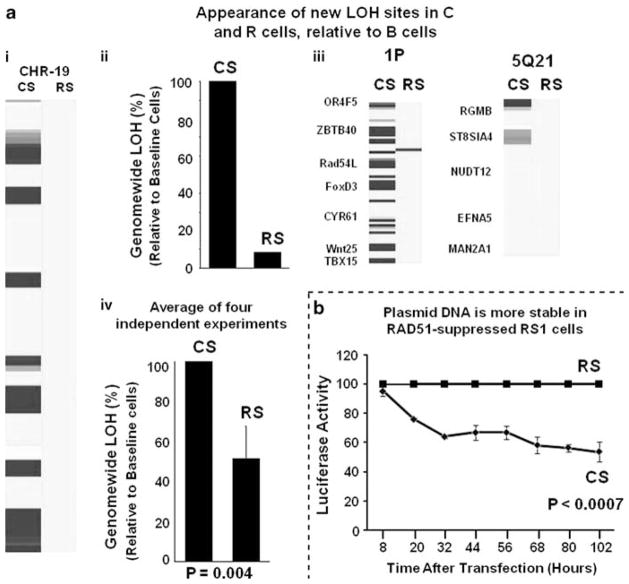Figure 6.
Suppression of RAD51 prevents acquisition of LOH in BAC cells. SNP data analyzed for copy number (presented in Figures 4 and 5) was also evaluated for LOH. Genotype calls from ‘day 0’ baseline cells were used to define the allele type baseline, departures from which identified new LOH loci in cells transduced with control or Rad51-shRNA cells. If LOH was detected in three or more consecutive SNPs, it was called one LOH event. (a) Impact of RAD51 suppression on acquisition of LOH loci in FLO-1 cells. Panel (I): blue bars show LOH loci acquired in chromosome 19 in one of the four experiments, in cells transduced with control CS or RAD51-shRNA RS and cultured for 33 days. Panel (II): for the experiment of panel (a), the total number of LOH events detected throughout the genome, in transduced relative to baseline cells, is presented as a percentage of control–shRNA-treated CS cells. Panel (III): for the same experiment, LOH loci are shown (indicated by blue bars) in the regions of the genome known to acquire LOH in esophageal adenocarcinoma. Panel (IV): bar graph shows genome-wide incidence of LOH events (that is, detectable change in three or more consecutive SNPs), as a percent of control shRNA-treated cells, in four independent experiments; error bars represent s.e.m. (b) Plasmid DNA is more stable in RAD51-suppressed cells. Control RS and RAD51-suppressed RS cells were transfected with a plasmid carrying Gaussia secretory luciferase and plated at equal cell density, in triplicate dishes. Starting 8 h after transfection, the Gluc activity in the supernatants was measured every 12 h. Gradual loss of Gluc activity in control cells is presented as percent of activity in RAD51-suppressed RS cells. A full colour version of this figure is available at the Oncogene journal online.

